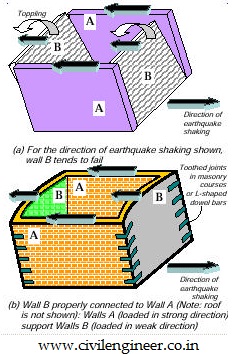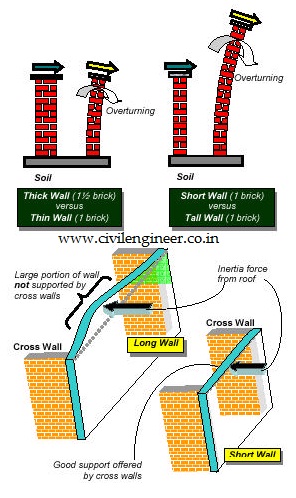
 Behaviour of Brick Masonry Walls Masonry buildings are brittle structures and one of the most vulnerable of the entire building stock under strong earthquake shaking. The large number of human fatalities in such constructions during the past earthquakes in India corroborates this. Thus, it is very important to improve the seismic behaviour
Behaviour of Brick Masonry Walls Masonry buildings are brittle structures and one of the most vulnerable of the entire building stock under strong earthquake shaking. The large number of human fatalities in such constructions during the past earthquakes in India corroborates this. Thus, it is very important to improve the seismic behaviour
of masonry buildings. A number of earthquake-resistant features can be introduced to achieve this objective.
Ground vibrations during earthquakes cause inertia forces at locations of mass in the building. These forces travel through the roof and walls to the foundation. The main emphasis is on ensuring that these forces reach the ground without causing major damage or collapse. Of the three components of a masonry building (roof, wall and foundation)
(Figure 1a), the walls are most vulnerable to damage caused by horizontal forces due to earthquake. A wall topples down easily if pushed horizontally at the top in a direction perpendicular to its plane (termed weak direction), but offers much greater resistance if pushed along its length (termed strong direction) .
The ground shakes simultaneously in the vertical and two horizontal directions during earthquakes (Earthquake Tip 5). However, the horizontal vibrations are the most damaging to normal masonry buildings. Horizontal inertia force developed at the roof transfers to the walls acting either in the weak or in the strong direction. If all the walls are not tied together like a box, the walls loaded in their weak direction tend to topple.
To ensure good seismic performance, all walls must be joined properly to the adjacent walls. In this way, walls loaded in their weak direction can take advantage of the good lateral resistance offered by walls loaded in their strong direction .
Further, walls also need to be tied to the roof and foundation to preserve their overall integrity.
How to Improve Behaviour of Masonry Walls
Masonry walls are slender because of their small thickness compared to their height and length. A simple way of making these walls behave well during earthquake shaking is by making them act together as a box along with the roof at the top and with the foundation at the bottom. A number of construction aspects are required to ensure this box action. Firstly, connections between the walls should be good.
This can be achieved by (a) ensuring good interlocking of the masonry courses at the junctions, and (b) employing horizontal bands at various levels, particularly at the lintel level. Secondly, the sizes of door and window openings need to be kept small. The smaller the openings, the larger is the resistance offered by the wall. Thirdly, the tendency of a wall to topple when pushed in the weak direction can be reduced by limiting its length-to-thickness and height-to thickness ratios (Figure 3). Design codes specify limits for these ratios. A wall that is too tall or too long in comparison to its thickness, is particularly vulnerable to shaking in its weak direction (Figure 3).
 Choice and Quality of Building Materials
Choice and Quality of Building Materials
Earthquake performance of a masonry wall is very sensitive to the properties of its constituents, namely masonry units and mortar. The properties of these materials vary across India due to variation in raw materials and construction methods. A variety of masonry units are used in the country, e.g., clay bricks (burnt and unburnt), concrete blocks (solid and hollow), stone blocks.
Burnt clay bricks are most commonly used.
These bricks are inherently porous, and so they absorb water. Excessive porosity is detrimental to good masonry behaviour because the bricks suck away water from the adjoining mortar, which results in poor bond between brick and mortar, and in difficulty in positioning masonry units. For this reason, bricks with low porosity are to be used, and they must be soaked in water before use to minimise the amount of water drawn away from the mortar.
 Various mortars are used, e.g., mud, cement-sand, or cement-sand-lime. Of these, mud mortar is the weakest; it crushes
Various mortars are used, e.g., mud, cement-sand, or cement-sand-lime. Of these, mud mortar is the weakest; it crushes
easily when dry, flows outward and has very low earthquake resistance. Cement sand mortar with lime is the most suitable.
This mortar mix provides excellent workability for laying bricks, stretches without crumbling at low earthquake
shaking, and bonds well with bricks. The earthquake response of masonry walls depends on the relative strengths of brick and mortar. Bricks must be stronger than mortar. Excessive thickness of mortar is not desirable. A 10mm thick mortar layer is generally satisfactory from practical and aesthetic considerations. Indian Standards prescribe the preferred types and grades of bricks and mortars to be used in buildings in each seismic zone.
